I’ve labored in digital advertising and marketing and Web optimization for over a decade. 5 years in the past, I dedicated totally to Web optimization. I grew to become actually obsessed with it and have since shared hundreds of posts on LinkedIn about all issues Web optimization.

It was a steep studying curve to chop by means of the noise and perceive the Google rating components that truly matter and people who don’t, and now I’m right here to share them with you.
Google’s algorithm is huge. There’s loads that performs into it, and the reality is, none of us is aware of how the algorithm works in its entirety (sure, even with the “algorithm leak”).
That stated, passionate SEOs are testing the algorithm on a regular basis and sharing their thrilling findings. I’ve now acquired years of expertise behind me and a portfolio of internet sites which can be producing tens of millions upon tens of millions of clicks.
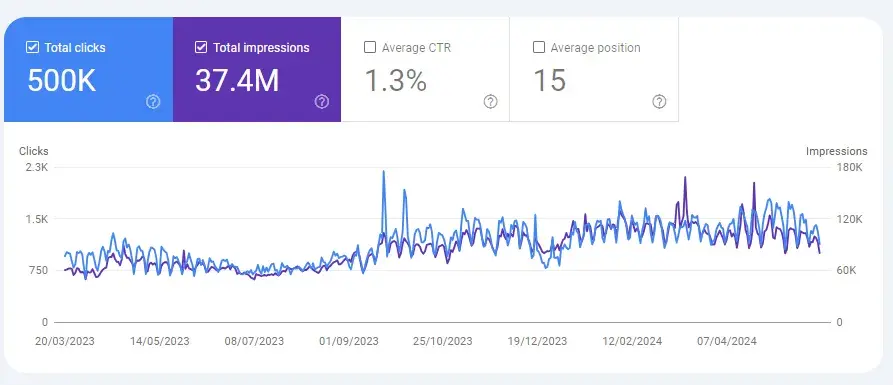
On this article, I’ll share the Google rating components that truly matter (beginning with the highest 10, in my view). All through, I’ll share Web optimization experiments and screenshots from Google Search Console to offer some proof of how my understanding of the rating components has helped me.
Oh, and I’ve acquired quotes and opinions from a few of the greatest SEOs I do know, too!
On this article:
What’s a rating issue on Google?
Rating components are the standards Google makes use of when evaluating pages to resolve the very best order of related outcomes to return for a search question.
Understanding rating components is important for efficient Web optimization. All entrepreneurs, content material creators, and Web optimization strategists needs to be aware of them.
This isn’t as a result of they‘re the end-all, be-all of Web optimization (they’re not), however as a result of they assist create a greater consumer expertise, which ensures extra leads and conversions for what you are promoting.
Lately, Google has began offering extra details about rating components and how search works.
HubSpot is making it simple to see how your content material is acting on Google with our AI Search Grader microapp. This is likely one of the first instruments in the marketplace that may make it easier to monitor how your content material is acting on AI search engines like google.
What number of Google rating components are there?
There are over 200 rating components which can be usually thought-about right (however once more, it is debatable). Since 2006, there have been hundreds of algorithm updates together with an API leak.
With every replace, SEOs take a look at to see what’s modified. So, a few of these components are confirmed, however others are hypothesis.
Did the algorithm leak educate us something new?
There are a number of actually essential issues to notice concerning the algorithm leak:
- Whereas hundreds of paperwork had been launched, we don’t understand how a lot of the algorithm we truly acquired insights into.
- From the API leak, we are able to infer that components are rating components, however we don’t actually know.
- Though the documentation has been analyzed by a few of the greatest within the {industry}, we’re counting on their interpretation of the documentation.
- We don’t understand how a lot every issue contributes to the algorithm when it comes to weighting.
For essentially the most conscientious SEOs, the leak wasn’t a shock. All through this text, I’ll share important findings and opinions from the leak and the way they could help my issues about rating components.
In my view, nice Web optimization is conversely much less about algorithms and rating components and extra about sensible advertising and marketing, offering useful content material to these searching for it. In the end, when you work to create the absolute best web site, in time, you’ll rank.
Let’s have a look at the highest 10 rating components and the way you should utilize them to enhance your Web optimization.
Prime 10 Google Rating Components
Let’s begin with the ten most essential rating components in my view. On this part, I’m sharing 10 components that I consider have had a direct correlation with my website’s rankings.
These components made the shortlist as a result of I feel they’re efficient and a precious consideration for all web sites. Anybody studying this could take these components significantly.
These are the rating components that I consider considerably influenced:
- Improved consumer expertise.
- Optimized conversion charges.
- Perceived trustworthiness.
- Promoted buyer retention and loyalty.
- Dramatically elevated clicks and impressions and helped herald excessive quantities of natural month-to-month site visitors.
Let’s dive in.
1. Useful, Dependable Content material
Google has all the time emphasised useful, dependable, and high quality content material. Offering content material that gives worth and distinctive insights not discovered on each different web site can enhance your rating.
With the rise of AI, you’ll be stunned what number of web sites are categorically failing to create high quality content material.
There’s excellent news for individuals who work laborious to craft each phrase and do their due diligence. You’ll be glad to know that as Google algorithms develop and get smarter, the poor, unhelpful, unreliable content material will finally get penalized and even fall out of Google’s index totally.
The picture beneath demonstrates how a website with less-than-reliable and useful content material misplaced nearly all of its natural site visitors together with the March replace.
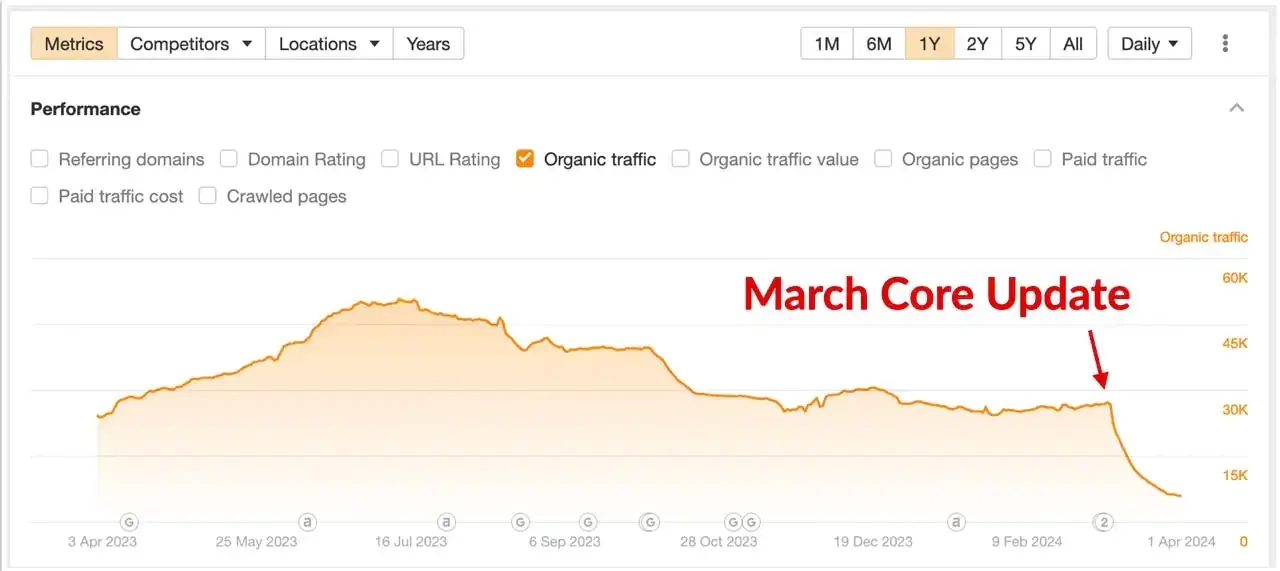
How you can Create Useful and Dependable Content material
Earlier than I bounce into the following tips, I need to say that AI content material is just not inherently dangerous. You should utilize AI as a part of your content material manufacturing course of, however usually, it’s essential to edit it and add your distinctive insights.
To create useful content material, you need to:
- Guarantee you’re the topic knowledgeable in what you might be writing about or that you just perceive that subject in-depth, in accordance with analysis.
- Rent topic specialists to jot down your content material.
- Present factual data that informs your viewers concerning the questions which can be an important to them.
- Add hyperlinks to your analysis and sources.
- Do not write fluff.
How you can Conduct SERP Evaluation
If you wish to rank on the primary web page, cease writing skinny content material. Analysis has confirmed time and time once more that content material that covers all areas, whether or not lengthy or quick type, tends to do higher in search outcomes.
You need to conduct SERP evaluation, plus:
- Research your rivals’ content material and write about what they missed.
- Cowl all related areas and reply all questions that readers may need.
- Make the textual content readable by including parts like photos, a clickable desk of contents, bounce hyperlinks, and CTAs to related data.
How you can Hit the Mark on Content material Size
Content material size is one factor that a number of folks debate about in terms of Web optimization. Some consider an upward of two,000 phrases needs to be the usual. Nevertheless, this isn’t all the time the case.
[Embed link: https://x.com/JohnMu/status/1637530426540523522]
Certain, long-form content material appears to get essentially the most backlinks, nevertheless it’s essential that you just write long-form solely whenever you want that to cowl your entire subject.
You would possibly need to test what rating articles have coated when it comes to phrase rely as a result of that may be an indicator of what Google is prioritizing. If all rating articles have between 2,000-4,000 phrases and also you write 200 phrases, you’ll probably not rank excessive for that time period.
Write your content material so long as it must be with out including fluff.
2. Content material Freshness
For those who’re rating effectively for a desired key phrase, you’ll need to preserve that rank by enhancing content material when the time is correct.
For conscientious content material creators, whenever you hit publish, the contents of your article are true and proper. However, as issues develop, it might be that your content material may benefit from an edit to maintain it factually correct and dependable.
I like to recommend going again to content material when it’s worthwhile to make an adjustment and edit it. Don’t edit content material for the sake of it or attempt to recreation the system by altering publication dates when nothing has modified.
Simply be sincere and diligent (bear in mind: useful and dependable).
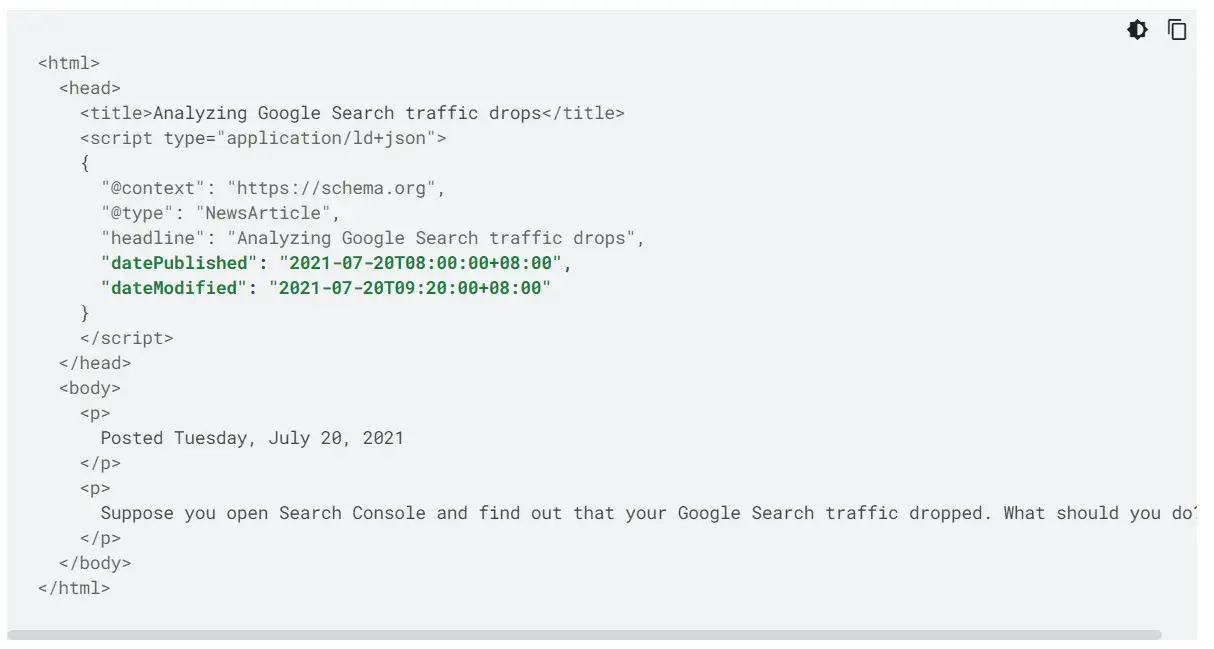
As aforementioned, in terms of Web optimization and rating components, the very best factor you are able to do is present useful content material for these searching for it.
Utilizing the publication date above for example, sharing the info from an article that was revealed (and modified) is genuinely useful to your consumer. They are going to perceive whether or not or not they’re getting up to date data.
It’s essential to notice that in its documentation, Google says, “Add a user-visible date to the web page and have it prominently. Label your dates appropriately with textual content like ‘Publish’ or ‘Final up to date.’”
Be warned: Google doesn’t need content material creators to recreation the system. They’ve a piece titled “Keep away from creating search engine-first content material.”
It supplies the reader with inquiries to ask to find out whether or not or not the content material is useful and dependable, the documentation probes the query, “Are you altering the date of pages to make them appear recent when the content material has not considerably modified?”
Marco Genaro Palma, Freelance CMO and Web optimization Guide at GenaroPalma.com, shares my emotions on content material freshness being a rating issue. He says, “One key takeaway from the Google leak was the significance of content material freshness, evaluated by means of metrics like ‘byline date,’ ‘syntactic date,’ and ‘semantic date.’
“Whereas I‘ve all the time suggested my shoppers to maintain their content material up to date, I’m now emphasizing this greater than ever.
“Retaining materials present and related has change into essential. I’ve applied a rigorous replace schedule, encouraging shoppers to revisit articles and guides so as to add the newest data and enhancements.”
How you can Create Contemporary Content material
To maintain your content material recent, I like to recommend these greatest practices:
- Edit content material when it wants it.
- Be diligent and replace revealed or modified dates. At the very least add the date to the article; when you’ve got some developer help, add schema as advisable by Google, too.
- Carry on prime of trending subjects inside your area of interest.
3. Creator Bylines
I strongly consider that articles ought to have assigned bylined authors. Creator bylines are helpful for readers, as they assist them see who wrote the article, which may also help construct belief.
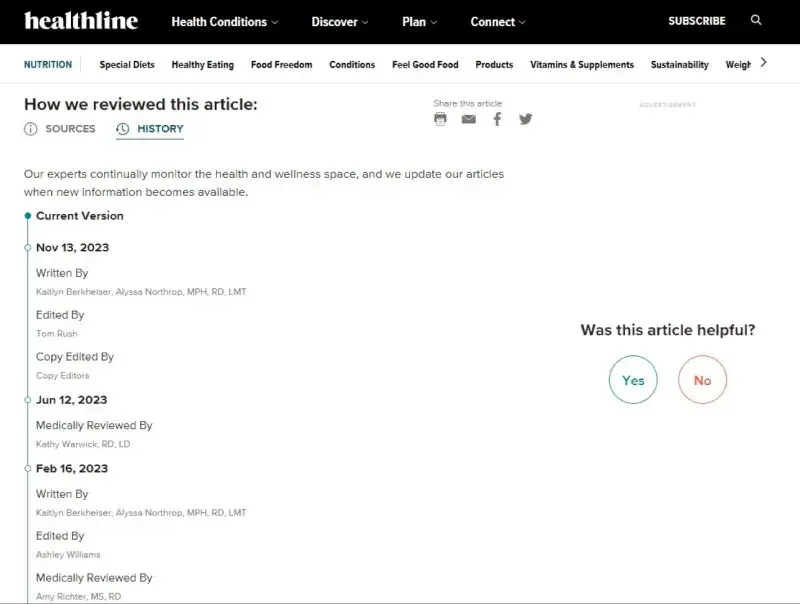
Whereas authors assist folks perceive that an article was written by a reputable supply, some proof means that Google additionally considers authorship a rating issue.
First, Google Search Central means that the authority of the content material creator is essential. Google Search Content material means that articles ought to have:
- Creator bylines the place customers would possibly count on it.
- Proof of who created content material.
- Linkable bylines resulting in creator pages with additional particulars.

It’s value me saying, for stability, that authors usually are not utterly obligatory for rating, and neither is any think about isolation, to be sincere! Creator-less pages rank effectively in lots of circumstances. I wrote a bit about that in my piece on E-E-A-T for SEOs.
Second, I’ve some anecdotal proof that authors are helpful for rating. On one website, specifically, my consumer and I had been struggling to rank a cluster of content material.
We’d written eight to 12 articles on a subject, all written by an {industry} knowledgeable.
Every bit of content material was well-researched, cited, and in-depth, and all my greatest Web optimization techniques had been in place, however nothing was taking place.
We determined so as to add creator performance to the positioning within the type of a byline and schema.
Days after the schema went dwell, the articles gained traction within the SERPs. After six months, clicks elevated from 94 to three,250 (+3,357%).
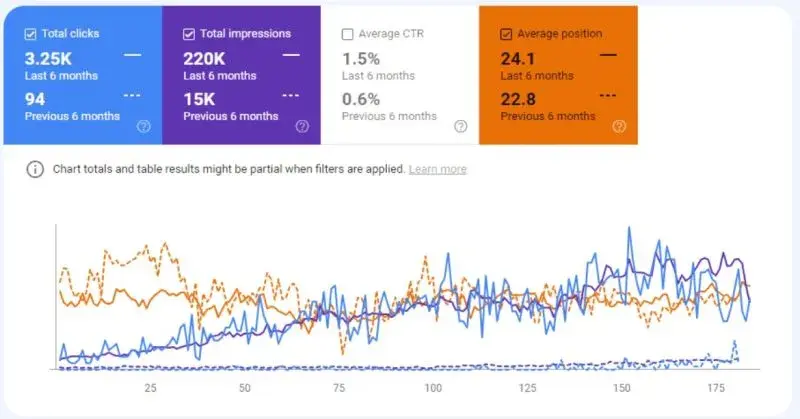
Different SEOs have discovered creator bylines and schema to be efficient.
James Oliver, Founder at Oliver.com, says, “Google values and shops data on content material creators and web site house owners, utilizing Boolean ‘isPublisher’ and ‘isAuthor’ options. This implies Google could use this knowledge to evaluate experience and authoritativeness, aligning with E-E-A-T ideas.”
Oliver continues, “[It’s implied] that Google‘s skill to establish these entities might considerably influence a website’s credibility, underscoring the significance of clear authorship and writer data for Web optimization success.”
How you can Add Creator Bylines
So as to add creator bylines, observe these steps:
- Merely add an creator byline to your articles.
- Perceive that crediting “firm staff” as an creator isn’t helpful. As a substitute, use full names.
- Take it a step additional and embody an creator schema when you can.
- Create detailed creator pages to hyperlink to from the article byline. Right here’s mine on HubSpot.
4. Inside Linking
Inside linking is my favourite Web optimization tactic. I simply love how easy however impactful it’s.
Inside hyperlinks are merely inline hyperlinks like this one: A hyperlink that goes from one web page in your web site to a different hyperlink in your web site.
For those who hyperlink to a website that isn’t yours (learn: a website on one other area), that’s an exterior hyperlink.
Inside hyperlinks are highly effective for Web optimization. They’re extremely helpful for Google, and most significantly, they’re helpful for customers.
By linking from one web page to a different, you’re serving to customers (and Google bots) uncover and transfer round your web site. A click on from one web page to a different is an indication of engagement, and also you’re probably taking your reader by means of a journey of your wonderful content material.
Rebekah Could, Web optimization and Content material Advertising Skilled at MarketingAid.io, is listening to engagement components like inner linking.
Could says, “I am going to enhance my give attention to optimizing for on-site consumer engagement metrics and click-through charges from search. This entails testing titles and descriptions, bettering content material formatting, inner linking, and incorporating extra multimedia to maximise CTR and time on web page.”
Inside hyperlinks assist Google uncover and index your content material. The bots observe from one web page on one topic and discover different high-quality, associated content material. You begin to appear like you understand a factor or two about what you say you do, and Google begins to belief and rank your web site.
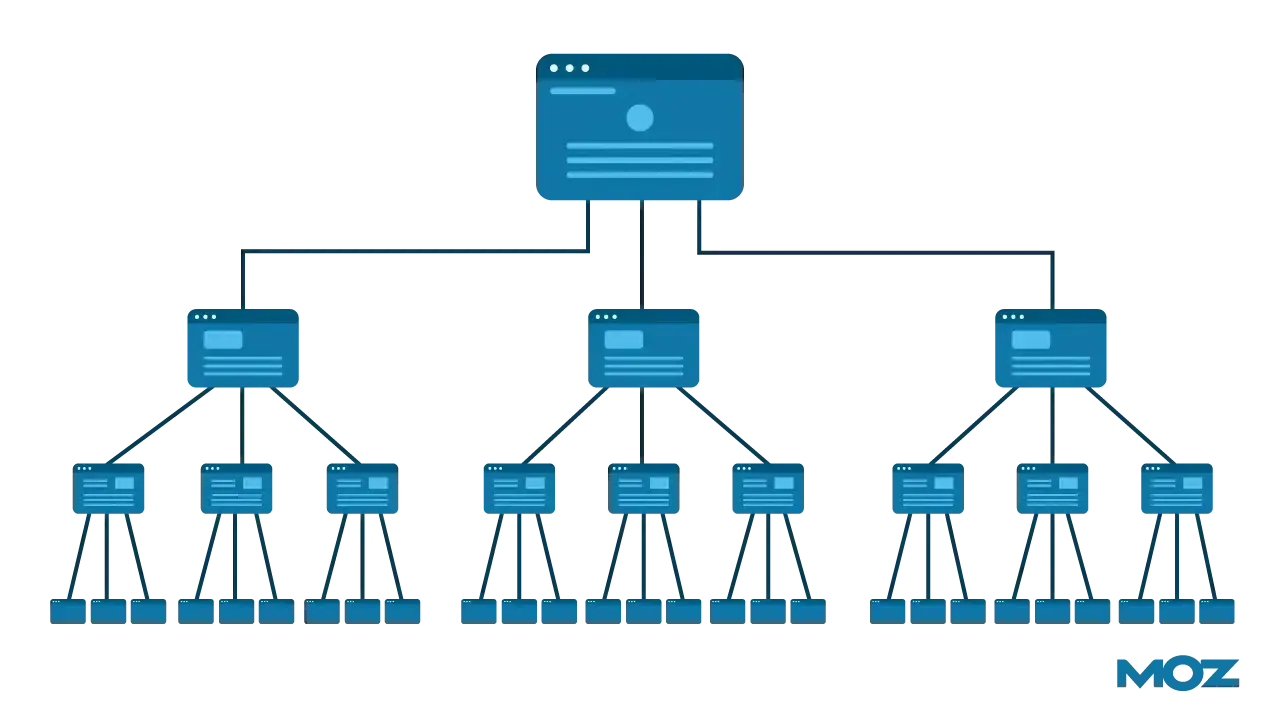
How you can Use Inside Hyperlinks
Listed here are some recommendations on how you can incorporate inner linking:
- Use hyperlinks naturally.
- Hyperlink related content material pages collectively.
- Add a “you might also like” part to the underside of articles.
5. Key phrase Placements
Google is getting smarter daily, however utilizing your key phrases properly offers you the very best likelihood of rating.
Earlier than I share the place to make use of your key phrases, there’s one factor to notice: A natural-reading article is extra essential than key phrase placements.
Most pages in your web site ought to have an assigned focus key phrase and supporting key phrases.
Usually, you’ll use your assigned focus key phrase within the:
- Web page’s H1 (often the title).
- URL.
- H2s, and perhaps H3s, the place pure.
- Physique textual content, the place pure, and ideally within the first paragraph if it is sensible.
The H1 is a sign of what your content material is about. So, embody your key phrase in your H1. Watch out, although; some SEOs say that utilizing the identical sentence in your H1 and meta title is a sign that you’re key phrase stuffing.
You would possibly need to spice it up a bit whereas nonetheless guaranteeing that your key phrase is current. Do that together with all on-page optimization (metadata, URL, different headings).
I prefer to maintain monitor of my focus key phrases in a spreadsheet. Right here’s what it seems like:
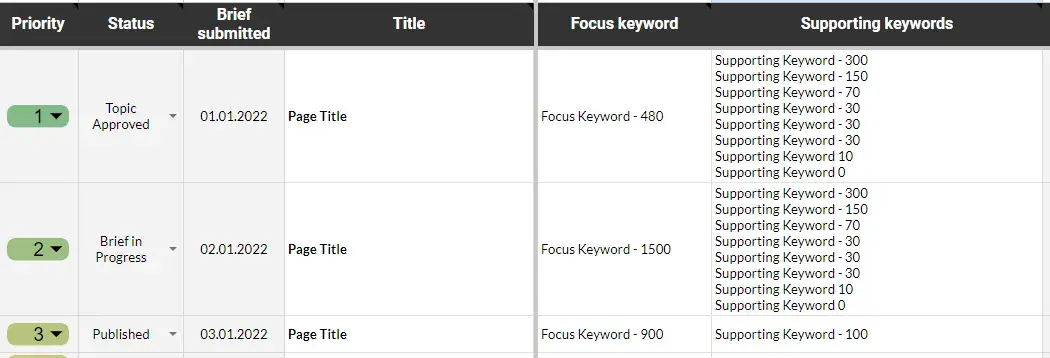
As regards to key phrase placements, it’s actually essential that I remind you that writing content material simply to rank key phrases isn’t excellent. Your content material needs to be high-quality and person-focused, not keyword-focused, however in fact, key phrases are finally what folks search.
Fellow Web optimization Praveen Kumar, Founder at Wild Creek Net Studio, stated it greatest: “[good content] satisfies the user-intent queries together with being in-depth and experience-driven reasonably than simply keyword-focused…One well-written piece of content material can get the viewers to maintain coming again for extra because it helps to construct belief and credibility.”
6. High quality Backlinks
Backlinks are a controversial subject in Web optimization. Many SEOs consider that they’re a rating issue, whereas others say they don’t seem to be.
The confusion isn’t a surprise when you think about the considerably combined messages that come from Google.
Generally, we hear that hyperlinks have gotten much less essential. On a podcast, John Mueller stated, “Over time, the burden on the hyperlinks will drop off somewhat bit as we won’t work out somewhat bit higher how the content material suits in inside the context of the entire net.”
<iframe title=“Libsyn Participant” model=“border: none” src=”https://html5-player.libsyn.com/embed/episode/id/24887220/top/90/theme/{custom}/thumbnail/sure/course/ahead/render-playlist/no/custom-color/ececec/“ top=”90“ width=”100%“ scrolling=”no” allowfullscreen webkitallowfullscreen mozallowfullscreen oallowfullscreen msallowfullscreen></iframe>
Nevertheless, different essential paperwork counsel that hyperlinks are essential.
In Google’s How Search Works content material, it says, “One in every of a number of components that we use to assist decide that is understanding if different outstanding web sites hyperlink or confer with the content material.”
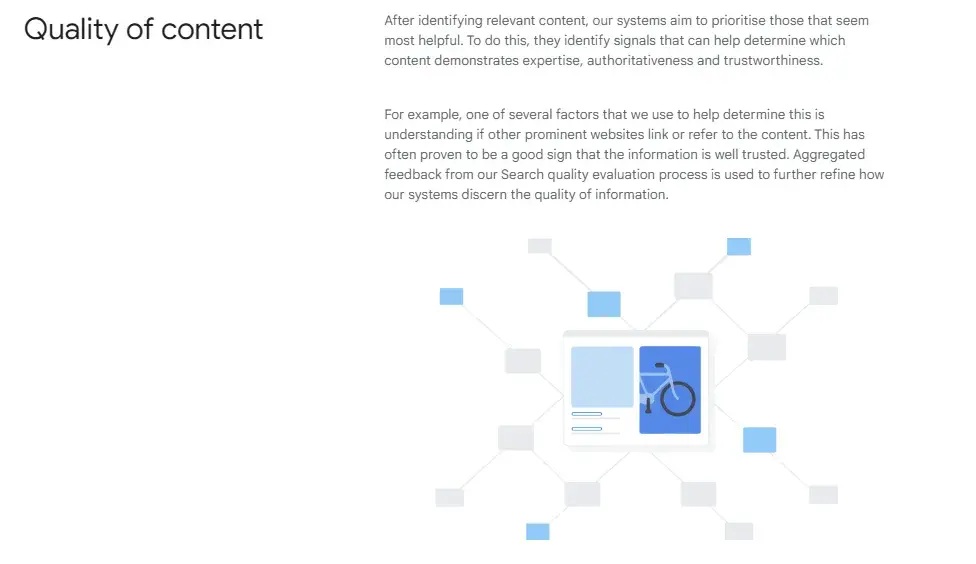
On the subject of topical authority and information, we all know that Google additionally components in hyperlinks. “If different outstanding web sites hyperlink or confer with the content material.”
That is essential as a result of it means that low-quality hyperlinks gained’t get you wherever. As a substitute, it’s best to focus your efforts on incomes your hyperlinks actually from credible sources in your {industry}.
How you can Use Backlinks
- Write nice content material that earns hyperlinks organically (bear in mind from earlier: in-depth content material naturally earns extra hyperlinks).
- Earn your hyperlinks from PR.
- Don’t pay for hyperlinks from spammy or irrelevant websites.
The entire variety of your backlinks and referring domains are essential, however solely when they’re from related sources. In February 2021, John Mueller commented concerning the significance of hyperlink relevance and you can construct many backlinks, however Google will ignore them if they don’t seem to be related.
Moderately than specializing in constructing tens of millions of backlinks, give attention to extra related and high quality backlinks.
Leigh McKenzie, group advocate at Visitors Assume Tank, wasn’t stunned when backlinks gave the impression to be a rating issue in accordance with the API leak.
McKenzie stated, “I am personally locked in on its backlink findings. Notably, that backlink profile high quality issues far more than amount in terms of rewarding your website.”
McKenzie notes that this should not be a shock to anybody who takes Web optimization significantly, however having it spelled out so clearly is telling.
In response to McKenzie, some people, particularly if their website is youthful, nonetheless see hyperlink constructing as a numbers recreation. The leak solely emphasizes that receiving dofollow backlinks from a handful of high-DA, authoritative web sites strikes the needle far more than fishing for any hyperlink.
“These high quality websites give Google’s algorithms a nod of approval again to your personal web site, with rating and natural site visitors positively influenced accordingly,” McKenzie says.
McKenzie says her staff was already specializing in white-hat link-building techniques, however the leak additional emphasizes that work.
“We’re funneling extra staff time and technique into earned visitor posting on third-party websites with a excessive relevance match to our viewers, reclaiming hyperlink schemes, intentional and Web optimization-guided blogger outreach, and changing website mentions into dofollows,” McKenzie says.
7. Web site Area Authority
As regards to backlinks comes Area Authority (DA).
Let me get this straight: It’s not a rating issue, regardless of what many say, and the easy purpose is that Google didn’t create it. When requested if it was a sign, John Mueller replied, “It’s a instrument by Moz.”

However from my perspective, it is good to bear in mind as a result of Moz makes use of specific indicators to create that rating (and different instruments like SEMrush and Arel=“ noopener” goal=“_blank” hrefs) which can be comparable to Google’s rating components.
When extra trusted websites are linking to yours, and you’ve got content material that ranks effectively, that’s an indicator that you ought to be trusted, which in flip will increase your rankings even additional — all of which performs into DA.
I nonetheless use Area Authority. After I’m desirous about a website and whether or not or not I can rank for a desired key phrase, I take advantage of Area Authority to assist me resolve if it’s potential.
For instance, if I need to rank for a key phrase like “Google rating components,” I’d Google it and test the authority of the positioning’s rating. Within the screenshot beneath, we are able to see that the highest three articles have a Moz Area Authority of 45 to 74.
HubSpot has a website authority of 93, so I’d say it has a very good likelihood of creating the highest spots for this key phrase. My company web site, with a website authority of 20, has a low likelihood of creating the highest spots.
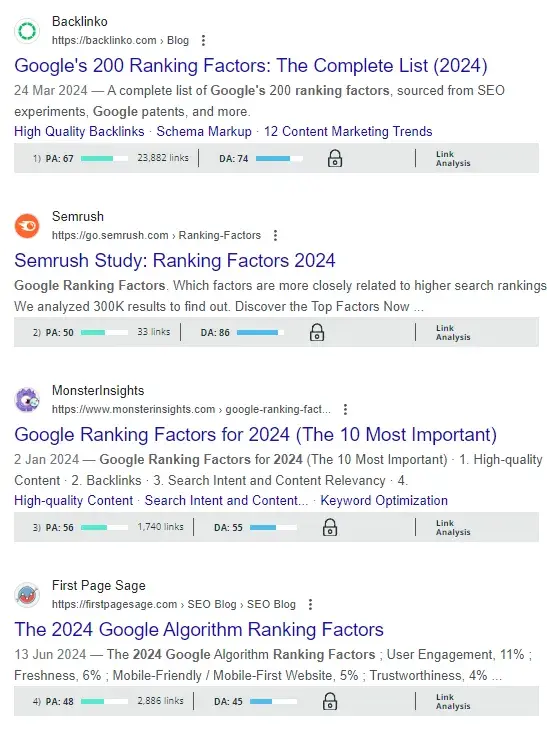
All this stated, area authority ought to by no means put you off your key phrase technique. In truth, for much less aggressive SERPs, even a website with a really low area authority can rank loads effectively sufficient! I’ve acquired a model new weblog with a website authority of two, rating on web page one for rigorously chosen key phrases.
James Taylor, Web optimization strategist at Embryo, understands the nuance of utilizing area authority as an indicator of your web site’s rating potential. Taylor says, “Regardless of what has been stated over the past 12 months, hyperlink constructing continues to be a core side of the algorithm, and website authority is a really actual factor.”
This doesn‘t imply you can work off estimated area authority alone, Taylor notes. “Nevertheless, it’s definitely an element when contemplating your link-building methods and justifies long-term link-building as a method of growing the authority and stage of belief to your personal web site over time,” says Taylor.
8. Branding
I’ve coated the worth of branding and Web optimization earlier than. Branding, particularly website mentions, stirred dialogue inside the Web optimization group after the Google algorithm leak.
Paul Buddy, head of Web optimization at The Web optimization Works, explains the position of branding and the leak. Buddy says, “The significance of brand name for Web optimization was strongly implied by the fallout of Google’s Useful Content material Replace, and the leaked API documentation appears to strengthen this as a key consideration for continued rating success with Google.”
Buddy says that Google’s paperwork deliver into focus the significance create a compelling provide and a powerful model in your area of interest, even when plenty of this work is finished primarily exterior of Google’s natural search ecosystem.
“One clear instance of brand-related exercise that each one SEOs ought to give attention to is sourcing model mentions and hyperlinks from websites that may ship actual customers your method.
Incomes actual mentions, protection, and hyperlinks as a result of what you are promoting is being legitimately talked about by related, industry-specific publications and different companies in your area of interest appears to be the important thing, at the very least till the subsequent leak!” Buddy says.
Chris Kirksey, CEO at Course.com, shares the identical sentiments as me and Buddy. Kirksey says, “The leak confirmed what I all the time suspected: constructing a model and getting it talked about, clicked, and searched boosts search engine success.”
Kirksey says he now places extra of a give attention to educating shoppers about model constructing and implementing methods to extend Entity Mentions. These embody:
- Serving to shoppers earn knowledgeable quotes and mentions by answering writer questions.
- Encouraging user-generated content material that naturally contains model mentions, like on Reddit.
- Utilizing PR and media relations to safe mentions in information articles and {industry} blogs.
- Optimizing web sites with related entities to ascertain associations within the Data Graph.
“The leak exhibits that Web optimization success isn’t just about backlinks but in addition about anchor texts, relevancy, mentions, and their high quality. By prioritizing Entity Mentions, we’re additional serving to shoppers construct authority, relevance, and search visibility — in different phrases, their model and their success in natural search,” Kirksey says.
How You Can Get Your Model Talked about
- Get cited in {industry} publications.
- Interact an incredible PR staff.
- Use sensible instruments like Featured, HARO, or Qwoted.
I’ve used Featured to pitch for alternatives to get talked about and linked to my web site, and I’ve had a 55% success fee. I extremely suggest it!
9. Web site Structure and Crawlability
How effectively your website is constructed will influence how simply Google can crawl it and the way simply customers can discover it.
A poor website structure will end in a poor expertise for customers.
Peter Rota is an Web optimization I respect on LinkedIn. He’s the Senior Technical Web optimization Supervisor at Peter Rota Web optimization and values the significance of a well-built website.
Rota says, “I‘ve all the time centered on making a website simple to crawl for Google, having it well-organized, simple to make use of, and never losing the consumer’s time by getting straight to the information.”
Ben Poulton, founding father of Intellar Web optimization Consultancy, shares Rota’s enthusiasm for a website that’s simple to make use of.
Poulton says, “With clicks and dwell time being components, this implies SEOs want to essentially take into consideration how intuitive a web site’s construction and navigation is. You desire a web site to be usable but in addition provide simple discovery paths for crawling bots.”
Apparently, website structure and crawlability are components which have crossover with different rating components, engagement, and inner hyperlinks, for instance.
After I work on a brand new website, I almost all the time have a look at the positioning structure first. Website structure relates strongly to inner linking, however I feel it deserves a separate level right here as a prime 10 rating issue as a result of it considers the positioning a bit extra holistically (the navigation, the footer, and so forth.).
My favourite approach to see website structure is with Screaming Frog’s visualization instruments. I truly favor the 2D model however the 3D one seems cool.
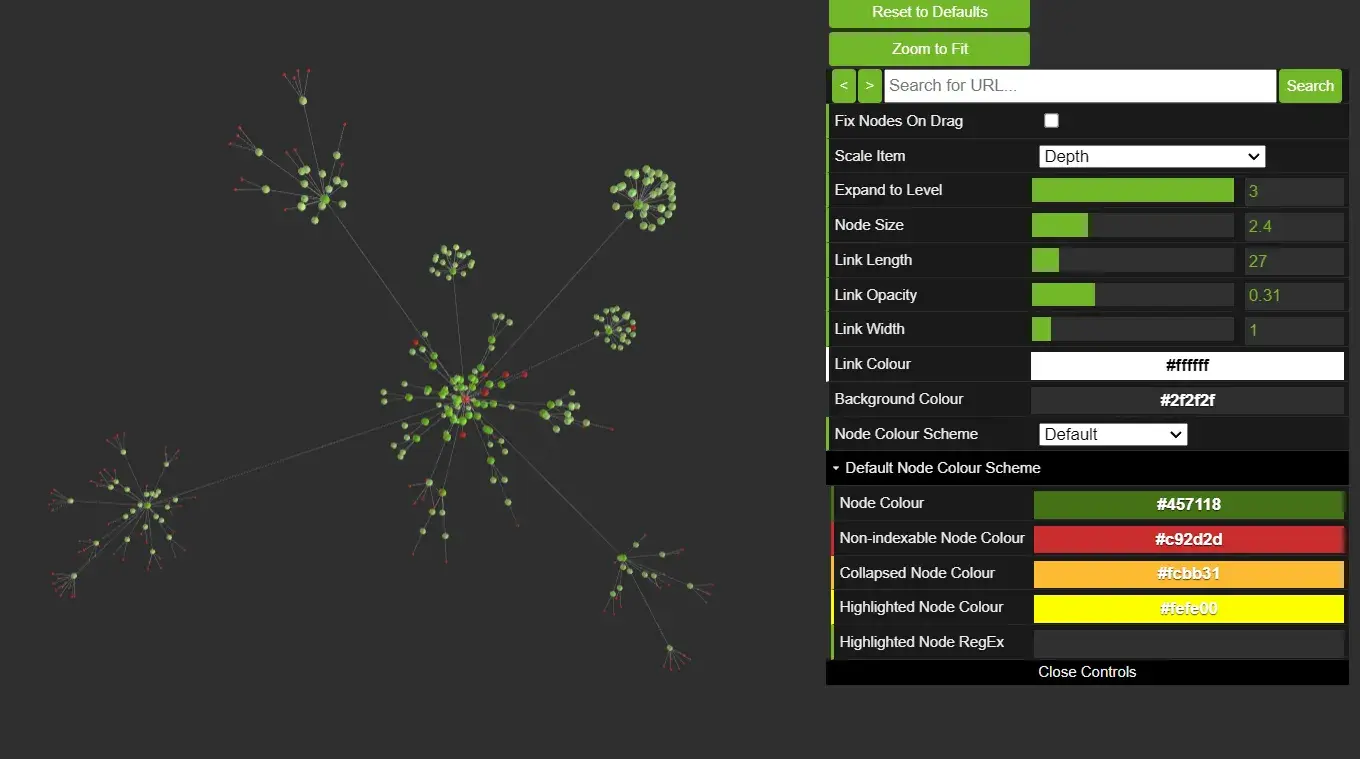
I take advantage of this instrument to audit the positioning’s pages. I can then see if Screaming Frog picks up on pages and the way the instrument “understands” the positioning structure.
website structure utilizing Screaming Frog permits me to see how a website is “put collectively.” Screaming Frog mimics Google crawling and supplies insights into issues. I not too long ago discovered a website that was crawling infinitely on account of a code bug.
Whereas this difficulty was an invisible downside for customers, their web site had 6,940 clean and ineffective pages listed.
How you can Assume About Web site Structure and Crawlability
This one is a little more technical, however there are some issues you are able to do:
- Use your robots.txt file to stop search engines like google from crawling unhelpful pages.
- Maintain your sitemap up to date.
- Observe greatest practices and ensure your navigation is logical.
10. Accessibility and Web page Pace
Web site accessibility and web page pace are all the time robust for me.
I need to embody them right here as a result of I feel they’re actually essential, particularly the accessibility ingredient. However they’re not likely one rating issue; they’re mainly an umbrella time period for a lot of.
Once we discuss accessibility, plenty of SEOs will take into consideration the worth of alt textual content, and this does weigh in, however there’s much more to it than that.
Accessibility covers a spread of things, equivalent to offering textual content alternate options for non-text content material, utilizing applicable heading buildings, and guaranteeing that colour contrasts meet readability requirements.
Your website needs to be obtainable for all folks to make use of. All of my websites have excessive accessibility scores.
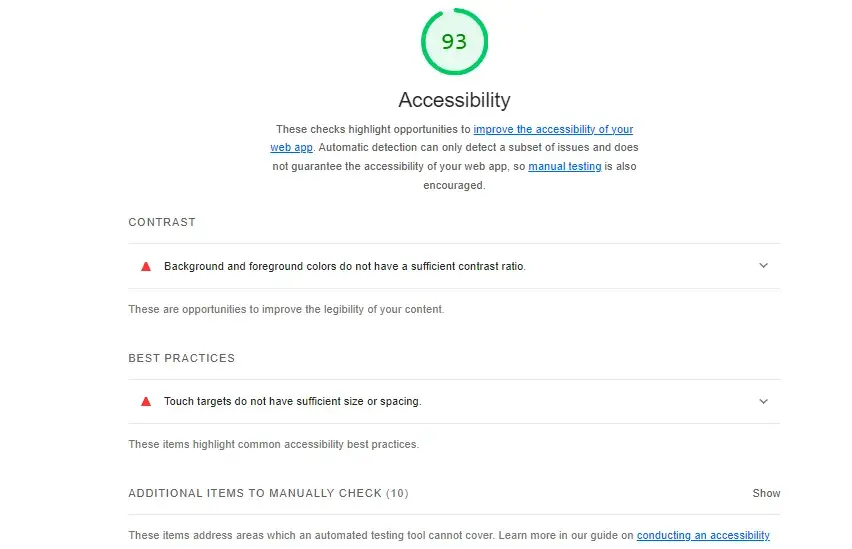
How you can Implement Greatest-in-Class Accessibility and Web page Pace
You’ll probably want a developer for this one. Google Lighthouse is a free instrument that may make it easier to discover accessibility and web page pace points.
Go to any website, click on F12, navigate to Lighthouse, and the report will probably be generated for you. A developer ought to have the ability to perceive the report, which can let you know what wants fixing and how you can do it.
- Use Lighthouse to establish points.
- Have a developer resolve as many issues as you may.
- Some issues will probably be very tough to resolve, as in, would require a rebuild of your web site, so begin with duties which can be a) fast to do or b) the heavy hitters when it comes to enhancements.
Lastly, cell usability. Nobody’s constructing websites that aren’t mobile-friendly anymore, proper? Consumer expertise is vital for Web optimization success and customers are more and more accessing your web site by way of cell. If you wish to rating factors with Google and, extra importantly, your customers, work in your cell usability.
Some B2B firms would possibly discover that almost all of tourists are utilizing desktops, however B2C manufacturers are more likely to have a excessive cell or pill utilization. You should utilize G4 to find out which units individuals are viewing your web site on.
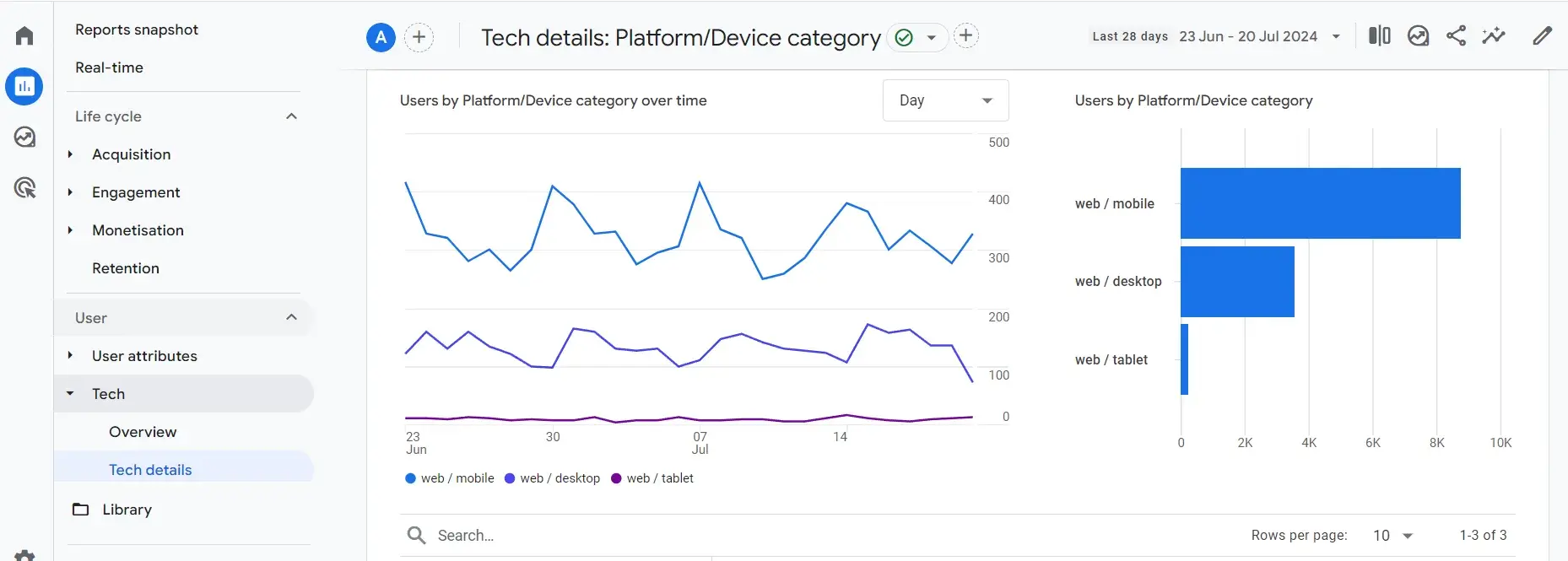
All At the moment Recognized Rating Components
Now that we’ve coated an important rating components intimately, it’s time for the enjoyable half: Stepping into the rundown of all 200 rating components.
Listed here are the highest classes:
- Area Components
- Web page-Stage Components
- Website-Stage Components
- Backlink Components
- Consumer Interplay
- Particular Google Algorithm Guidelines
- Model Indicators
- On-Website Webspam Components
- Off-Website Webspam Components
Area Components
Area components are all rating components that join together with your area (the fundamental instance.com model of your web site), together with the next.
1. Your area age is the size of time that your area identify has been registered. I’ve ranked very new domains on the prime of Google, so I don’t assume that is tremendous impactful, however I think it performs a task.
2. Key phrase in your area: Having a goal key phrase inside your area identify.
3. Key phrase is the primary phrase in your area: Having a goal key phrase as the primary phrase in your area identify.
4. Area registration size: The interval for which your area is registered.
5. Key phrase in subdomain: Together with a goal key phrase within the subdomain a part of your web site URL.
6. Area historical past: The previous possession and utilization data of a website. I had points with this once I purchased my area!
7. Penalized WhoIs proprietor: A website proprietor with a historical past of search engine penalties.
8. Public WhoIs as an alternative of personal WhoIs: Utilizing public WHOIS data, making area possession particulars seen.

Web page-Stage Components
Web page-level components are components on every web page you can optimize, equivalent to the next.
1. Presence of the key phrase within the title tag: Together with the goal key phrase within the net web page’s title.
2. Having the key phrase initially of your title tag: Inserting the goal key phrase initially of the net web page’s title.
3. Presence of the key phrase within the H1 tag: Together with the goal key phrase in the principle heading of the net web page.
4. Key phrase is ceaselessly used within the content material: Utilizing the goal key phrase all through the content material. Bear in mind to be very pure about this.
5. Content material size: The entire variety of phrases within the content material. HubSpot discovered that the best phrase rely for Web optimization and articles was 2,100 to 2,400 phrases. However the excellent size for leads was 2,500 phrases. I counsel you write naturally and make your pages so long as they must be.
6. Phrase rely rankings: The connection between phrase rely and the way effectively a web page ranks in search outcomes.
7. Presence of a linked desk of contents: Having a desk of contents with hyperlinks to sections inside the content material. I all the time do that; it makes the article extra navigable for customers so it looks like an incredible function so as to add.
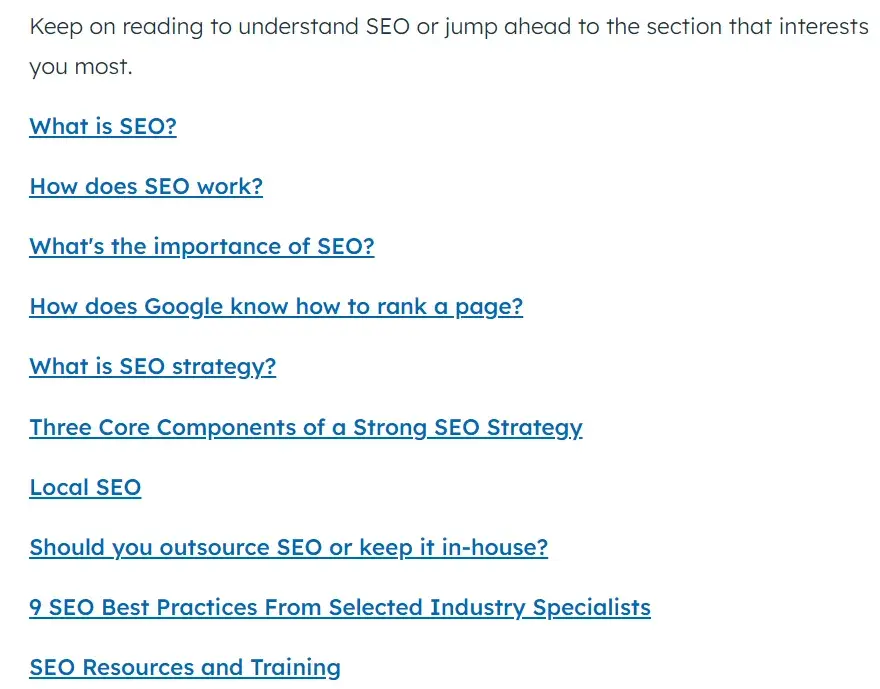
8. Key phrase density: The proportion of occasions the goal key phrase seems within the content material relative to the entire phrase rely. Key phrase density could think about, however I think about it’s much less essential than it was once. Key phrase density garnered some controversy when Google talked about it of their course for Web optimization learners.
9. Presence of semantically associated key phrases: Together with key phrases which can be contextually associated to the principle key phrase. Most good writers will embody semantic key phrases naturally.
10. Semantically associated key phrases in meta title and outline: This contains associated key phrases within the meta title and outline tags.
11. In-depth high quality content material: Offering thorough and complete data on the subject.
12. Helpful content material: Creating content material that gives worth and sensible data to the consumer.
13. Web page loading pace by way of HTML: The pace at which an online web page masses as measured by its HTML efficiency.
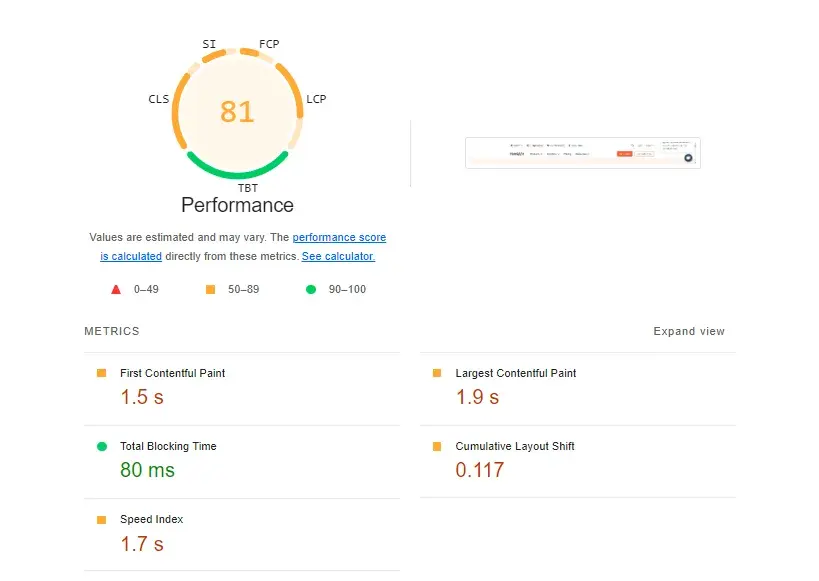
14. Web page loading pace examined on Chrome: The pace at which an online web page masses when examined utilizing the Chrome browser. I like to think about web page loading pace as a tie-breaker, however I’ve some anecdotal proof of a web site zooming to the highest of Google after we did web page pace work! My normal rule is that if a website feels quick sufficient, it most likely is.
15. Core net vitals: Key metrics that measure the general consumer expertise of an online web page, together with loading, interactivity, and visible stability. Yow will discover your CWV knowledge in Google Search Console.
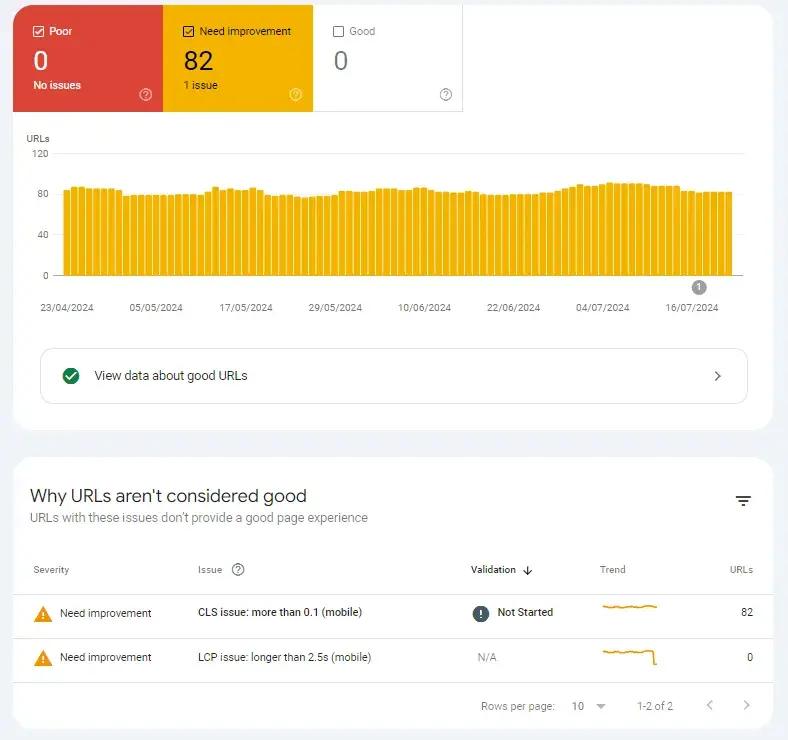
16. No duplicate content material on the identical website: Guaranteeing that content material is exclusive and never repeated elsewhere on the identical web site. Some duplicate content material is okay, in my view, however strive to not over-do it. By no means have content material from one other website with out citing it, or utilizing canonicals, although!
17. Picture optimization by means of ALT, title, and file identify: Bettering photos for Web optimization by utilizing descriptive ALT textual content, titles, and file names. Picture optimization additionally has some web page pace advantages.
18. Content material recency (the newer, the higher): The freshness of the content material, with newer content material being most popular. It is a large one for me!
19. Web page age: How lengthy the net web page has been revealed.
20. What number of edits had been made to the content material throughout updates: The variety of modifications made to the content material over time.
21. Historic knowledge on web page updates: Information of when and the way typically the web page has been up to date.
22. Correct use of rel=canonical: Utilizing the rel=canonical tag to point the popular model of an online web page to keep away from duplicate content material points.
23. Presence of key phrase in H2 and H3 tags: Together with the goal key phrase in subheadings (H2 and H3 tags) of the content material.
24. Presence of key phrase within the first 100 phrases: Utilizing the goal key phrase inside the first 100 phrases of the content material. Usually, I do strive to do that. I need to see the key phrase within the first paragraph or two.
25. Grammar and spelling: Guaranteeing the content material is free from grammatical and spelling errors. Prime tip for grammar and spelling, you may crawl for grammatical and spelling errors utilizing Screaming Frog!
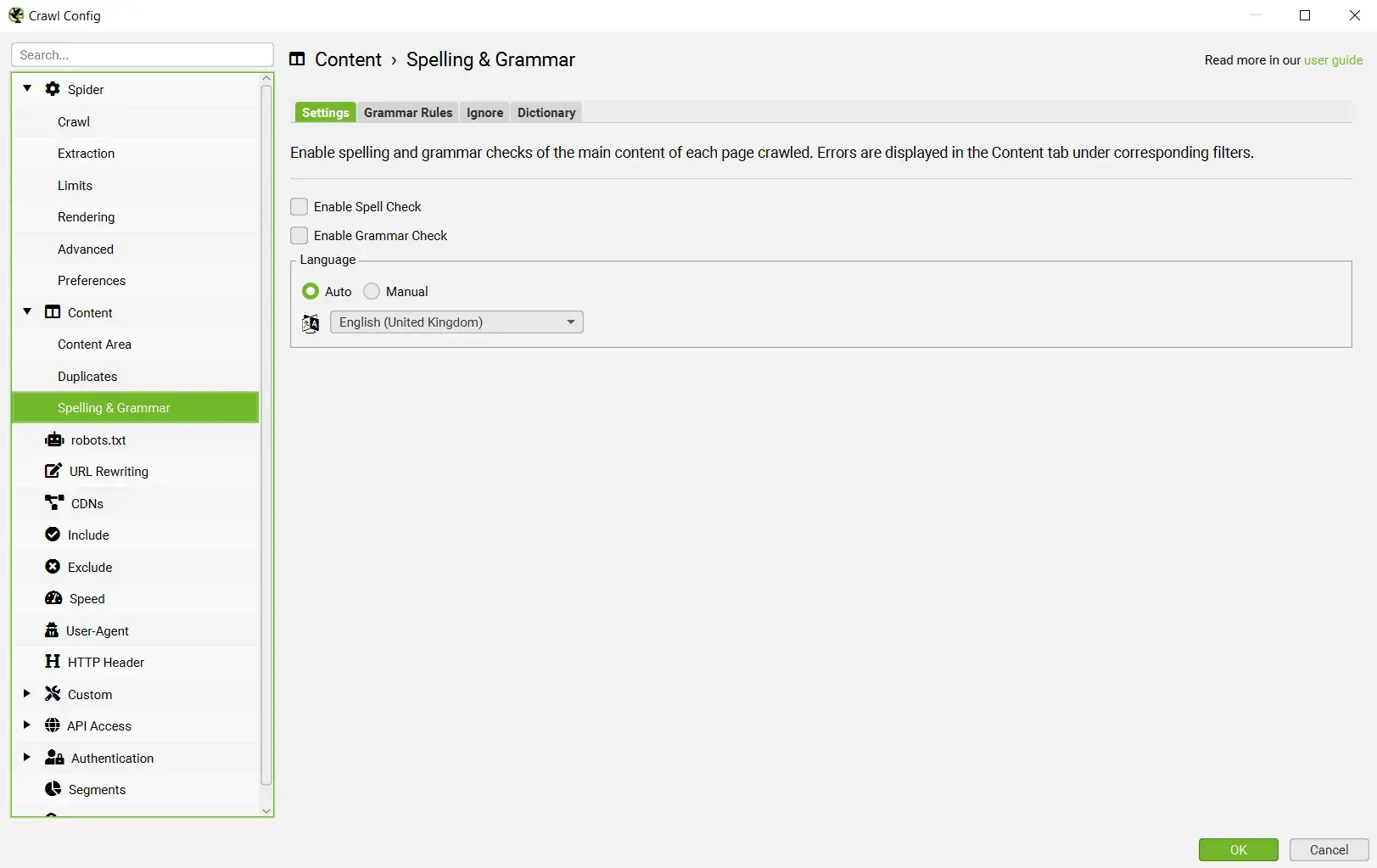
26. Originality of the web page’s content material: Guaranteeing the content material is exclusive and never copied from different sources.
27. Entity match: Together with related entities (folks, locations, issues) that match the subject of the content material.
28. Cell usability and optimization: Guaranteeing the net web page is straightforward to make use of and navigate on cell units.
29. Hidden content material on cell (is probably not listed): Content material that’s hidden on cell units may not be listed by search engines like google.
30. Web page optimized for cell: Guaranteeing the net web page performs effectively on cell units, together with quick loading occasions and responsive design.
31. Presence of multimedia, for instance, photos and movies: Together with numerous varieties of media like photos, movies, and infographics within the content material.
32. Variety of outbound hyperlinks: The rely of hyperlinks out of your web page to different web sites.
33. The standard of outbound hyperlinks: Guaranteeing the exterior hyperlinks level to respected and related websites.
34. Theme of outbound hyperlinks: Guaranteeing the outbound hyperlinks are related to the content material’s subject.
35. Presence of useful supplementary content material, like free instruments and calculators: Together with extra assets equivalent to instruments, calculators, and guides that present further worth.
36. Variety of inner hyperlinks pointing to the web page: The rely of hyperlinks from different pages in your website to the web page in query.
37. High quality of the interior hyperlinks: Guaranteeing inner hyperlinks come from high-quality and related pages inside your website.
38. Presence of too many damaged hyperlinks (might decrease rating capabilities): Having too many non-functional hyperlinks in your web page can negatively influence its rating. It’s not good for customers to click on a hyperlink and never have the ability to entry the content material.
39. The studying stage of the web page: The complexity of the language used within the content material, aimed toward a selected viewers’s comprehension stage. The Hemingway App is an effective way to test the “grade” of your website. Keep in mind, not all websites want to jot down to the identical grade. It depends upon the viewers.
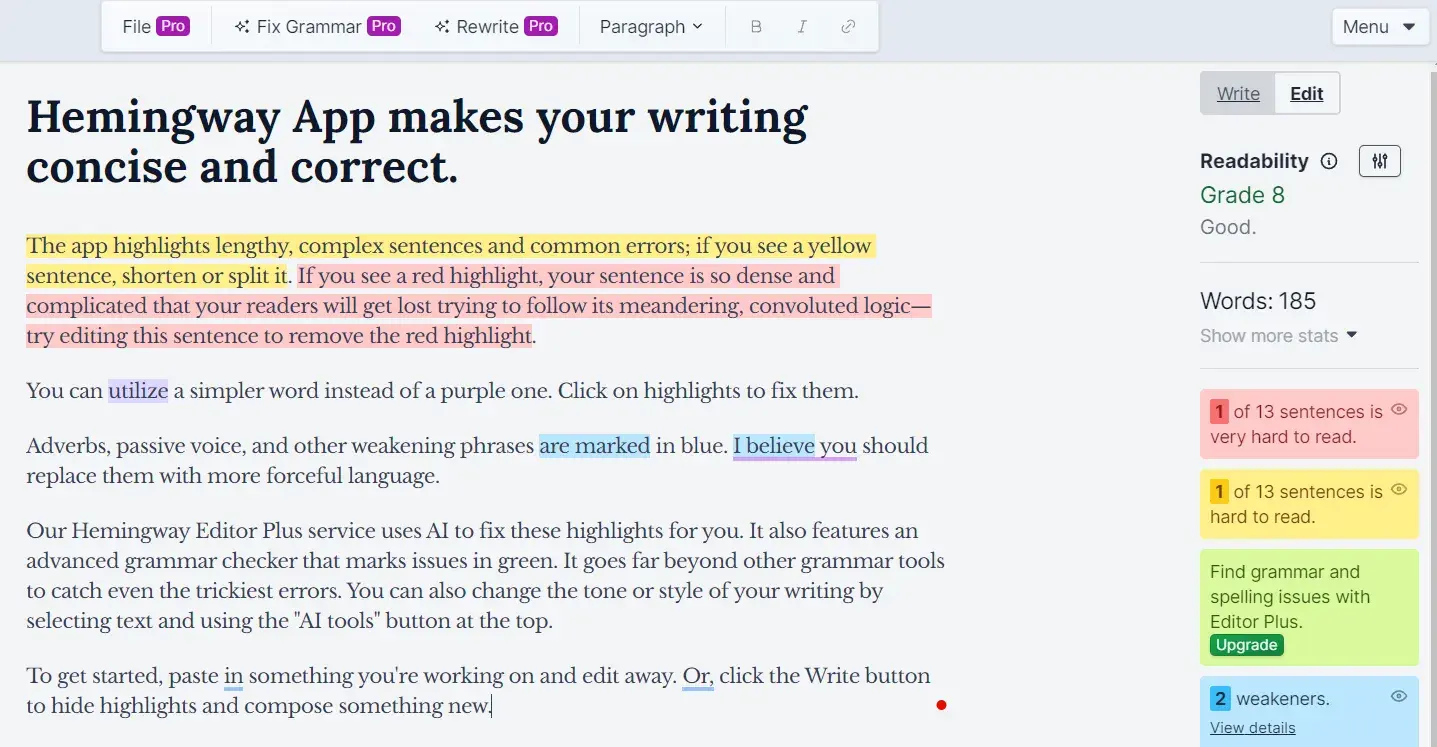
40. Presence of many affiliate hyperlinks: Having a major variety of affiliate hyperlinks, which could have an effect on the web page’s credibility and consumer expertise. Lots of affiliate websites felt the influence of the March replace.
41. Presence of many HTML errors: Having a number of coding errors within the HTML of your web page, which may have an effect on efficiency and Web optimization.
42. Authority/belief stage of the area: The general credibility and trustworthiness of your web site’s area.
43. Authority/belief stage of the web page: The credibility and trustworthiness of a selected net web page, typically influenced by backlinks and content material high quality.
44. PageRank: A Google algorithm metric that evaluates the significance of an online web page primarily based on the standard and amount of its backlinks.
45. Size of URL: The entire variety of characters in an online web page’s URL, with shorter URLs typically being most popular. Attempt to keep away from spammy-looking URLs — plenty of irrelevant numbers, for instance.
46. Closeness of URL to the homepage: The proximity of the net web page to the homepage inside the website’s URL construction. Good website construction resolves this.
47. Presence of key phrase in URL: Together with the goal key phrase within the net web page’s URL.
48. Opinion of human editors: The subjective analysis of an online web page’s high quality by human reviewers. There’s a staff of actual human editors who fee websites in accordance with Google’s rater pointers.
49. Relevance of web page’s class to web page: Guaranteeing the web page is categorized in a related part of the web site.
50. Content material formatting for user-friendliness and readability: Structuring content material with headings, bullet factors, and quick paragraphs to reinforce readability.
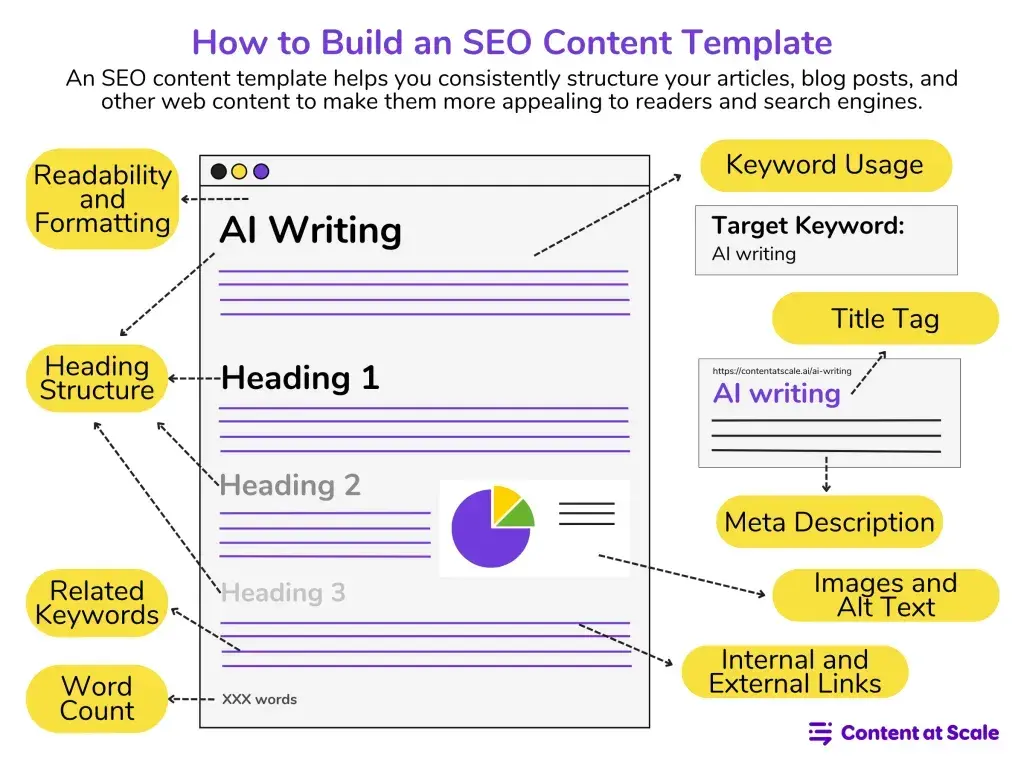
51. Precedence of the web page within the sitemap.xml: Assigning a precedence stage to the net web page within the sitemap.xml file to information search engine crawlers.
52. UX sign from pages rating for a similar key phrase: Consumer expertise metrics from different pages rating for a similar key phrase that affect search engine rankings.
53. Citing references and sources: Together with citations and references to help the content material’s credibility and reliability.
54. Use of a user-friendly structure: Designing the net web page structure to be simple to navigate and visually interesting.
55. URL string in Google search engine outcomes: How the URL seems in Google search outcomes, affecting click-through charges.
56. Inside hyperlink anchor textual content to the web page: The clickable textual content of inner hyperlinks pointing to the net web page, ideally containing related key phrases.
57. Use of structured knowledge: Implementing structured knowledge (schema markup) to assist search engines like google perceive the content material and context of the net web page.
Website-level Components
Website-level components go above the web page stage and check out issues on your entire website. They embody the next.
1. Presence of a “contact us” web page or applicable quantity of contact data: Together with a devoted web page or part with methods to contact the enterprise enhances credibility.
2. Content material on website supplies worth or new insights: Creating content material that’s informative, helpful, or presents recent views to customers.
3. TrustRank: A metric that measures how intently linked your website is to trusted and authoritative websites.
4. Web site updates for freshness issue: Commonly updating the content material on the positioning to maintain it present and related.
5. Website structure: The construction and group of the web site’s pages and hyperlinks.
6. Presence of a sitemap: Having a sitemap.xml file helps search engines like google crawl and index the positioning extra effectively. Discover out what a sitemap is and how you can create it.
7. Lengthy-term website downtime: Extended intervals when the web site is unavailable, negatively impacting consumer expertise and Web optimization.
8. Location of server: The bodily location of the server internet hosting the web site, which may have an effect on loading pace and search rankings.
9. HTTPs/use of a sound SSL certificates: Utilizing HTTPS to safe the web site, which helps shield consumer knowledge and may enhance search rankings.
10. Presence of authorized pages (phrases and situations and privateness coverage): Together with authorized data pages that improve belief and adjust to rules.
11. Distinctive metadata: Guaranteeing every web page has distinct meta titles and descriptions to keep away from duplication and enhance Web optimization.
12. Use of breadcrumb markup: Implementing breadcrumb navigation to assist customers and search engines like google perceive the positioning construction. Listed here are some nice examples of breadcrumbs finished effectively.
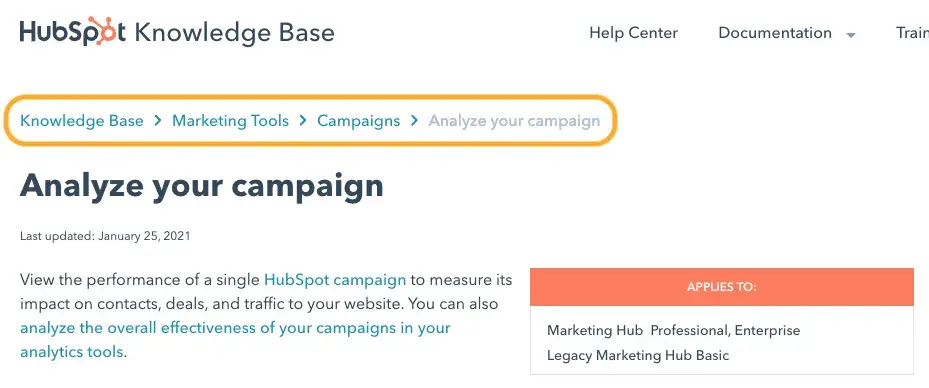
13. Sitewide cell optimization: Guaranteeing your entire web site is optimized for cell units.
14. Sitewide user-friendliness (usability and interactiveness): Designing the web site to be simple to make use of and interactive throughout all pages.
15. Bounce fee: The proportion of tourists who depart the positioning after viewing just one web page, indicating consumer engagement ranges.
16. Consumer evaluations: Suggestions from customers concerning the website or enterprise, influencing fame and belief.
17. Website fame: The general notion and credibility of the positioning primarily based on consumer suggestions, evaluations, and belief indicators.
Backlink Components
Backlink components have a look at the websites which can be linking to you to find out the place to rank your web page. Websites with higher high quality websites linking to them are typically greater in rankings once they have high quality content material. The backlink components are as follows.
1. Age of linking area: How lengthy the area linking to your website has been registered.
2. Variety of referring domains: The entire rely of distinctive domains that hyperlink to your website.
3. Variety of hyperlinks from separate C-class IPs: The variety of backlinks coming from completely different C-class IP addresses, indicating hyperlink range.
4. Variety of referring pages: The entire rely of particular person pages that hyperlink to your website.
5. Anchor textual content of backlinks: The clickable textual content in a hyperlink pointing to your website. You’ll be able to overdo this with “precise match anchors,” so all the time attempt to be pure. There’s a free lesson on constructing backlinks right here.
6. ALT tag of picture hyperlinks: The ALT textual content utilized in picture hyperlinks that time to your website describes the picture content material.
7. Variety of hyperlinks from .edu and .gov domains: The rely of backlinks from instructional and authorities domains.
8. Belief issue of the linking web page: The credibility and trustworthiness of the web page linking to your website.
9. Belief issue of the linking area: The credibility and trustworthiness of the area linking to your website.
10. Presence of hyperlinks from rivals: Hyperlinks coming from competitor web sites.
11. Variety of hyperlinks from anticipated websites in your {industry}: Backlinks from websites which can be related and anticipated inside your {industry}.
12. Hyperlinks from dangerous neighborhoods: Hyperlinks from web sites recognized for spam or low-quality content material.
13. Variety of hyperlinks that aren’t from advertisements: The rely of backlinks that aren’t paid commercials.
14. Nation TLD of referring domains: The country-specific top-level area (TLD) of websites linking to you, indicating geographic relevance.
15. Presence of some nofollow hyperlinks: Having backlinks with the “nofollow” attribute, indicating a pure hyperlink profile. On the subject of backlinks, I’d fear much less about dofollow or nofollow and give attention to relevancy as an alternative. Right here’s a information on how you can get hold of nice backlinks.
16. Range of hyperlink profile: A various mixture of backlinks from various kinds of websites and sources.
17. Context of the content material of the linking web page: The relevance and high quality of the content material on the web page linking to your website.
18. Presence of extra observe hyperlinks than sponsored or UGC: Having extra commonplace (observe) hyperlinks in comparison with sponsored or user-generated content material (UGC) hyperlinks.
19. Plenty of backlinks to URLs with 301 redirects: Many backlinks pointing to URLs which were redirected utilizing a 301 redirect.
20. The textual content that seems whenever you hover over a hyperlink: The title attribute textual content that exhibits up whenever you hover over a hyperlink.
21. Hyperlink location on web page: The precise space on the web page the place the hyperlink is positioned, such because the header, footer, or content material physique.
22. Location of hyperlink in content material: The place the hyperlink seems inside the content material, equivalent to inside the principle textual content or a sidebar.
23. Hyperlinks from related domains: Backlinks from domains which can be associated to your website’s subject or {industry}.
24. Hyperlinks from related pages: Backlinks from particular person pages which can be contextually associated to your website’s content material.
25. Presence of your web page’s key phrase within the title of the linking web page: The linking web page’s title comprises your goal key phrase.
26. Pure fee of development within the variety of hyperlinks: A gentle and natural enhance within the variety of backlinks over time.
27. Spiky and unnatural fee of development within the variety of hyperlinks: Sudden, unnatural surges within the variety of backlinks, which can look suspicious.
28. Hyperlinks from prime assets on a sure subject or hubs: Backlinks from authoritative and central websites in a selected subject space.
29. Variety of hyperlinks from websites which can be thought-about authority websites: The rely of backlinks from well-established and revered websites.
30. Linked as a supply in a Wikipedia article: Your website is cited as a reference in Wikipedia entries.
31. Phrases round your backlinks: The encompassing textual content close to your backlinks, offering context and relevance.
32. Backlink age: How lengthy the backlink has been pointing to your website.
33. Hyperlinks from actual websites vs. pretend blogs: Distinguishing backlinks from respectable websites in comparison with spammy or pretend blogs.
34. Pure hyperlink profile: A backlink profile that seems natural and contains quite a lot of hyperlink sorts and sources.
35. Extreme reciprocal hyperlinks: Having too many mutual backlinks between two web sites, which might be seen as manipulative.
36. Hyperlinks in actual content material vs. UGC: Backlinks inside unique content material in comparison with UGC, like feedback or discussion board posts.
37. Backlinks from a web page with a 301 redirect: Hyperlinks coming from pages which were completely redirected to a brand new URL.
38. TrustRank of linking website: The general trustworthiness and authority of the positioning linking to your web page.
39. Fewer outbound hyperlinks on the linking web page: Pages linking to your website have a restricted variety of outbound hyperlinks, which may point out greater hyperlink worth.
40. Hyperlinks in actual content material vs. hyperlinks in boards: Backlinks inside the principle content material of a web page in comparison with these present in discussion board discussions.
41. Phrase rely of linking content material: The entire variety of phrases on the web page that’s linking to your website.
42. High quality of linking content material: The general relevance, usefulness, and credibility of the content material that comprises the backlink.
43. Sitewide hyperlinks = one hyperlink: Hyperlinks that seem on each web page of a website (sitewide hyperlinks) are usually counted as a single backlink for Web optimization functions.
Consumer Interplay
Google all the time emphasizes in its replace bulletins how essential it’s to offer a wonderful consumer expertise to web site guests. These components measure consumer interplay to rank your web page accordingly.
1. Natural click-through fee for precise key phrase: The proportion of customers who click on in your web page in search outcomes particularly for the precise key phrase you’re focusing on.
2. Natural click-through charges for all rating key phrases: The typical proportion of clicks your web page receives for all of the key phrases it ranks for in search outcomes.
3. Dwell time: The period of time a consumer spends in your web page earlier than returning to the search outcomes.
4. Bounce fee: The proportion of tourists who depart your website after viewing just one web page, with out interacting additional.
5. Measurement of how customers work together in your website primarily based on RankBrain: How Google’s RankBrain algorithm interprets and reacts to consumer engagement and conduct in your website.
6. Whole direct site visitors: The variety of guests who come to your website by instantly typing the URL into their browser or utilizing a bookmark.
7. Proportion of repeat guests: The proportion of tourists who return to your website greater than as soon as.
8. Blocked websites: Web sites which can be restricted or blocked by customers, typically on account of safety or privateness considerations.
9. Proportion of tourists that click on on different pages on the SERP after visiting your web page: The proportion of customers who click on on different search outcomes after visiting your web page.
10. Web page ceaselessly bookmarked by Chrome customers: The variety of occasions customers save your web page as a bookmark in Chrome.
11. Variety of feedback on web page: The entire rely of consumer feedback or interactions in your web page.
Particular Google Algorithm Guidelines
Some Google Algorithm guidelines usually are not instantly related to your web page or area. They embody components that have a look at personalizing search outcomes for the consumer or higher search outcomes as a complete. Listed here are a few of them.
1. Want for range within the SERP: The requirement for search engine outcomes pages (SERPs) to indicate quite a lot of content material sorts and sources.
2. Want for freshness within the SERP: The significance of displaying up-to-date and up to date content material in search outcomes.
3. Searching historical past of consumer: The document of internet sites and pages a consumer has visited, which may affect customized search outcomes.
4. Search historical past of consumer: The log of key phrases and queries a consumer has beforehand looked for, affecting customized search outcomes.
5. Succinct solutions, formatting, web page authority, and HTTPS for featured snippets: The necessity for clear, well-formatted content material on authoritative HTTPS pages to be chosen as featured snippets.
6. Geo-targeting: Tailoring search outcomes to a consumer’s geographic location.
7. Grownup content material or curse phrases (excluded from secure search outcomes): The filtering out of specific content material or offensive language from secure search outcomes.
8. Excessive content material high quality requirements for YMYL key phrases: Guaranteeing high-quality, reliable content material for “Your Cash or Your Life” subjects, which influence customers’ well being, funds, or security.
9. Respectable DMCA complaints: Legitimate requests for removing of copyrighted content material, which may have an effect on search visibility.
10. Want for area range in SERP: The need for search outcomes to incorporate hyperlinks from quite a lot of domains to offer balanced data.
11. Transactional searches: Queries with industrial intent, typically aimed toward making a purchase order or finishing a transaction. The SERPs look very completely different for transaction key phrases; have a look at the instance beneath, that’s plenty of buying advertisements!
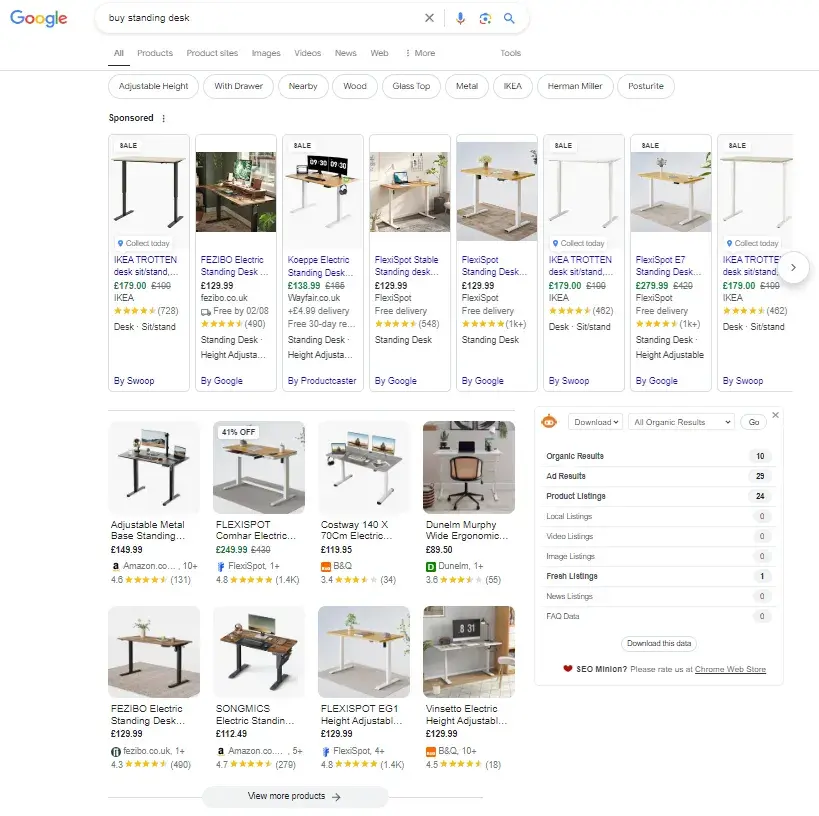
12. Native search outcomes: Search outcomes which can be tailor-made to the consumer’s native space or geographic location.
13. Presence of stories tales associated to the key phrase for the Prime Tales field: The show of present information articles related to the search key phrase within the Prime Tales part
14. Search intent: The underlying purpose or goal behind a consumer’s search question, equivalent to discovering data, making a purchase order, or fixing an issue.
15. Presence of huge manufacturers with related content material (they’re typically ranked greater): The tendency for well-known manufacturers to rank greater in search outcomes on account of their authority and relevance.
16. Presence of outcomes optimized for Google Purchasing: The inclusion of product listings and advertisements from Google Purchasing in search outcomes for industrial queries.
17. Picture outcomes: Search outcomes that embody photos associated to the search question.
18. Branded search: Queries that embody a selected model identify, typically resulting in outcomes associated to that model.
19. Easter eggs and April Fools’ Day jokes and hoaxes from Google: Enjoyable or playful surprises, like hidden options or jokes, created by Google, usually round April 1st.
20. Spammy queries: Search queries which can be related to low-quality or spammy content material.
21. Spammy websites: Web sites that have interaction in spammy practices, equivalent to key phrase stuffing or hyperlink schemes, which may negatively influence search outcomes.
Model Indicators
How nice is your branding technique when it comes to Web optimization? If you have not taken care of your model mentions and model everywhere in the web, it’s worthwhile to begin now.
As a result of there are some critical rating components associated to your model, together with the next.
1. Model + key phrase searches (for instance, HubSpot Web optimization): Searches that mix a model identify with a selected key phrase or subject.
2. Branded anchor textual content: Hyperlink textual content that features the model identify, utilized in backlinks to reinforce model recognition.
3. X profiles with followers: An X account for a model or person that has a considerable variety of followers, indicating social affect. I like to affix entities like social media accounts to web sites utilizing schema and “sameAs.”
4. Official LinkedIn web page: A LinkedIn profile for a model or person that serves because the official enterprise presence on the platform.
5. Fb web page with a number of likes: A Fb web page for a model or enterprise that has a excessive variety of likes, reflecting recognition and engagement.
6. Branded searches: Queries that particularly embody the model identify, typically indicating consumer intent to seek out details about the model.
7. Recognized creator or verified on-line profile: An creator or particular person with a acknowledged and verified on-line presence, including credibility and authority.
8. Actual social media accounts: Genuine and lively social media profiles for a model or particular person, versus pretend or inactive ones.
9. Prime tales with model mentions: Information tales or articles featured in search outcomes that point out the model.
10. Model mentions with out hyperlinks: Cases the place the model is talked about in content material with out a hyperlink pointing to the model’s web site.
11. Bodily location of workplaces: The geographical areas of a model’s bodily workplaces or enterprise premises, which may affect native search outcomes and credibility.
On-site Net
To rank excessive on search engine outcomes, it’s worthwhile to guarantee your website isn‘t spammy and doesn’t look spammy — as with many issues in life, seems play a task in how we’re perceived. Listed here are some components round that.
1. Low-quality content material: Content material that’s poorly written, not informative, or lacks worth, typically leading to a poor consumer expertise.
2. Hyperlinks to dangerous neighborhoods: Backlinks pointing to or from low-quality, spammy, or irrelevant websites, which may hurt Web optimization.
3. A number of and sneaky redirects: Utilizing extreme or misleading redirects to govern search engine rankings or cover content material.
4. Flagged server IP deal with: An IP deal with related to spammy or malicious exercise, which may influence search engine belief.
5. Distracting advertisements and popups: Ads and popups that intervene with the consumer expertise and may detract from content material readability.
6. Popups which can be spammy and tough to shut: Popups which can be intrusive, laborious to dismiss, and infrequently used for spammy or aggressive advertising and marketing.
7. Over-optimizing the positioning: Excessively making use of Web optimization techniques, equivalent to key phrase stuffing or overusing meta tags, can negatively have an effect on rankings.
8. Gibberish content material: Content material that’s nonsensical or meaningless, typically generated by automated instruments with out actual worth.
9. Use of doorway pages: Creating a number of low-quality pages designed solely to rank for particular key phrases and redirect customers to different websites.
10. Plenty of advertisements above the fold and never a lot content material: Having a major quantity of commercials seen earlier than the consumer scrolls, with minimal content material, which may hurt the consumer expertise.
11. Hiding affiliate hyperlinks: Concealing affiliate hyperlinks to make them much less noticeable or misleading, which might be thought-about unethical and dangerous to Web optimization.
12. Low-value content material websites: Web sites primarily stuffed with content material that lacks substance or usefulness, typically used for hyperlink constructing or advert income.
13. Affiliate websites: Web sites centered primarily on selling affiliate merchandise, which might be seen as low-quality in the event that they lack unique content material.
14. Key phrase stuffing in meta tags: Overloading meta tags with key phrases in an try to govern search rankings, which might be penalized by search engines like google. This feels very outdated hat now!
15. Laptop-generated content material: Content material created by automated instruments or algorithms with out human oversight, typically leading to low high quality or relevance.
16. Nofollowing all outbound hyperlinks: Utilizing the “nofollow” attribute on all exterior hyperlinks, which may forestall passing hyperlink fairness and diminish content material worth.
Off-site Webspam Components
The off-site webspam components have an effect on spam primarily based on what’s finished exterior your web site that connects together with your web site. They embody the next.
1. Unnatural and sudden enhance in backlinks: A fast and strange surge within the variety of backlinks, which can point out manipulative Web optimization practices.
2. Hacked website: A web site that has been compromised by malicious actors, typically resulting in safety points and a unfavorable influence on search rankings.
3. Plenty of low-quality backlinks: An abundance of backlinks from poor-quality or spammy websites, which may hurt Web optimization.
4. Excessive proportion of hyperlinks from unrelated web sites: A big portion of backlinks coming from websites that aren’t related to your content material or {industry}.
5. Low-quality listing hyperlinks: Backlinks from directories which can be of low worth or are poorly maintained, which may negatively influence Web optimization.
6. Computerized hyperlinks in widgets: Backlinks generated robotically by means of widgets or plugins, which can be thought-about low-quality or manipulative.
7. Hyperlinks from websites with the identical server IP: Backlinks from a number of websites hosted on the identical IP deal with, which may point out hyperlink manipulation.
8. Utilizing “poison” in your anchor textual content: Using overly aggressive or irrelevant key phrases in anchor textual content, which may result in penalties.
9. Ignored guide actions in search console: Failing to handle or rectify penalties or warnings issued by Google Search Console relating to guide actions.
10. Promoting hyperlinks: The apply of exchanging cash for backlinks, which is towards search engine pointers and may result in penalties.
11. Momentary hyperlink schemes: Quick-term, link-building techniques designed to artificially enhance rankings, typically resulting in unfavorable penalties when found.
Phew, we made it! Though this checklist might sound overwhelming, I’ve highlighted my prime 10 to make issues a bit extra palatable.
Changing into an Rating Issue Skilled
You‘ve now gotten to know the numerous recognized rating components and my most popular prime 10. Use this text as a information, not as a tough rule.
I’m not Google and solely Google can affirm what the precise rating components are. Most of this knowledge is from what I’ve seen from working with a number of web sites over time.
One essential factor to notice: don‘t overdo it — this serves as a reminder that you will need to prioritize optimizing for people, not the algorithm.
Whenever you over-optimize your pages, Google sees that you just’re attempting too laborious and would possibly consider you are attempting to recreation the system.
Bear in mind, consumer expertise is vital, so regularly optimize to your target market, and you’ll be duly rewarded.
Editor’s observe: This put up was initially revealed in July 2021 and has been up to date for comprehensiveness.
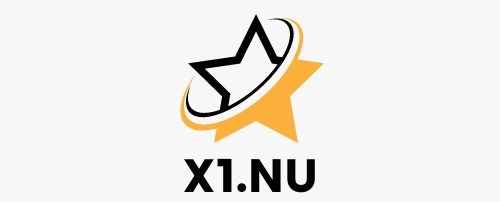

![→ Download Now: SEO Starter Pack [Free Kit]](https://no-cache.hubspot.com/cta/default/53/1d7211ac-7b1b-4405-b940-54b8acedb26e.png)